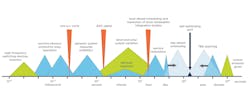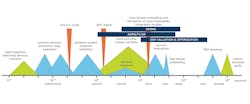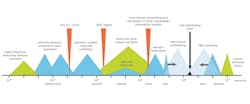Into the Void: Distributed Planning Poses Questions that Need to be Addressed
Electricity delivery presents many challenges. The grid must be balanced in real time all of the time. The laws of physics require that. Try to bend the rules and bad things happen. Disruptions that can be measured in single cycles can cause potentially catastrophic problems, yet utilities plan new lines and substations to last for decades.
The impact of distributed energy resources (DERs) is already being seen with the need for distributed energy resource management systems (DERMS) and increased distribution automation through the adoption of advanced distribution management systems (ADMS) that include functionality for fault location, isolation and service restoration (FLISR) and other functionality to improve customer service and grid reliability.
The deployment of DER is not showing signs of slowing down and as we see increased amounts of DER on the grid, future grid investment will require a valuation framework that considers the structure of an inclusive and extensible valuation framework that accounts for the value created by DER. This is necessary to account for the multiple dimensions involved in considering value associated with DER. With continued growth in types and uses of DER, a valuation framework will be a critical feature to enable transparency that achieves the broader social aims of economic value and importance from the perspective of both planning and operations. Using a transactive energy model of grid stability and reliability as this basis could provide consistent methods to address these challenges.
Owners and operators need visibility into structural changes to the distribution grid and into their facilities to support improvements to reliability and to rationalize the satisfaction of goals such as carbon reduction, fuels and system optimization, congestion costs, and customer needs. A valuation framework needs to assume that the measures of economic value and importance can be constructed as hard and soft in a fiat currency as cost reduction, cost avoidance, revenue and strategic value using a simplistic net cash flow model for both capital and operations and maintenance over a constrained time horizon sufficient for valuation.
With lower barriers to entry for small commercial operations and for end-use customers, due to low-cost consumer DER, storage, and private financing, the timescales for planning will need to become much shorter as new non-utility-owned assets appear more frequently on the grid. Already, utilities are being overwhelmed with interconnection requests and this trend is expected to continue unabated or even increase. Additionally, as local DER cause reverse flows and phase imbalances, the emergence of local (transactive energy) markets is expected to provide much-needed low-voltage dynamic balancing where the assets themselves can provide not only grid services but also provide insights into their capability to provide those services and recommendations for changes to local capabilities.
In the future, these changes will become much more dynamic than in today’s environment and will cause the temporal gap between operations and planning to shrink drastically as the void between them closes. We can no longer plan (largely radial) distribution grid changes, build them, and assume that they are operating as planned. We will need more looped schemes and more flexibility in how the grid is operated. The ability of DER to assess capabilities to provide service is one dimension of this complex valuation framework. This will include integrating these resources into local markets that include real and reactive power, capacity, ancillary services, and other services.Evaluation of the framework itself will require a deep technical dive into the approach to provide some degree of mathematical assurance that convergence on a valid solution will occur and be timely along with assurances that a conceptual framework for transactive energy systems will actually solve some of the processing problems in the grid. However, the proliferation of DER is not likely to go away. Valuing the DER contribution to grid stability and value creation through retail markets is just as important as being able to mitigate the uncertainty caused by their intermittent operation if we were to choose instead not to coordinate their activity.
There has been much discussion over the past decade about the need for more dynamic balancing of distributed resources utilizing concepts like transactive energy. These types of approaches are being researched and modeled as potential solutions for retail energy and grid services markets. There are barriers, however, including barriers that are erected by dependency on enabling regulation. However, these approaches represent a viable technical approach to operating grids more dynamically at lower voltages. A variety of mechanisms have been studied and implemented (PNNL, TeMIX, PowerMatcher, Introspective Systems, PowerLedger, LO3, Opus One, and others) yet these have understandably been focused largely on the operations domain.
Currently there is a conceptual and temporal void between operations and planning, but as the grid moves from being load following to supply following, and especially during the transition of years between these states where the drivers for operating philosophies may not be clear, that void will start to shrink. There will be a time where they start to converge and the transition from distributed operations will start to extend into distributed planning. The following figure is an edited version of the previous figure. It shows the shorter planning timescales and extended operations timescales converging to a point where they overlap. At that point, planning and operations become indistinguishable in some facets. This area is one that is a prime solution space for non-wires alternatives.
For this to work effectively, a distribution grid is envisioned that is much more networked and far less radial. In this temporal overlap of planning and operations, we will have a grid where the value of resources depends on other resources and the goal of the system will be not only continual self-optimization through physical reconfiguration and changing how devices are used, but also extrapolating the usefulness and efficacy of such options so that future extensibility can be integrated.
The existence of a percipient grid poses some challenges. For it to take on a distributed planning capability, it needs to be able to evaluate the new construction that has not yet been built, which could be addressed with software-in-the-loop inputs that the other devices recognize as being virtual, although this can introduce malware attack vectors. It also does not address the question of who should realize value from new configurations and new construction since this will be profit-driven if not utility-owned.
Since grid planning has always been the domain of electric utilities, the concept of distributed planning poses some interesting questions that need to be addressed. As distribution planning and operations start to converge, the grid will also be seeing increased demands from electrification. This will likely involve mobile storage in the form of vehicles and possibly mobile battery storage. This will create a need for unique device identifiers that may participate in multiple markets. As mobility and availability of responsive devices increase, this will necessitate the need for capabilities such as self-registration and other interoperability attributes.
Drivers of these trends will include distributed (artificial) intelligence and non-utility drivers. Perhaps by that (fast approaching) time, we will have rules for intelligent devices similar to Asimov’s laws for robots such that:
- A device may not injure a human being or, through inaction, allow a human being or the electric grid to come to harm.
- A device must obey the orders given it by human beings, except where such orders would conflict with the First Law.
- A device must protect its own existence as long as such protection does not conflict with the First or Second Law.
Food for thought.
About the Author
Mark Knight
Mark Knight is a principal consultant for the energy and utility industries at 1898 & Co., part of Burns & McDonnell. With more than 30 years of experience working for utility companies in the U.K. and the U.S. and as a consultant in the electric supply industry, he is focused on building comprehensive strategies that will improve business and technology solutions for clients. Mark is chairman emeritus of the GridWise Architecture Council and a member of the Institute of Asset Management (IAM). He has participated in several IAM teams to develop asset management guidelines.
Gerard Rendell
Gerard Rendell works at Duke Energy.


